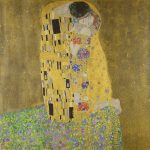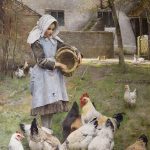Lucian Freud, a titan in the world of painting, is often celebrated for his intense, often unsettling portraits that capture the raw essence of his subjects. Yet, behind his groundbreaking work lies a personal story as intriguing as his art itself. This story involves his relationship with Kitty Garman, which significantly influenced his early work. Let’s explore how their partnership played a pivotal role in shaping Freud’s artistic journey.
Early Lives and Meeting
Lucian Freud was born in Berlin in 1922. He was the grandson of Sigmund Freud, the famous psychoanalyst. His family moved to London to escape the rise of National Socialism in Germany. Freud attended the Central School of Art in London, where he began to develop his unique style. During his early years, he was influenced by surrealism, though he later moved away from it.
Kitty Garman was born in 1926 in London. She was the daughter of Jacob Epstein, a renowned sculptor. Her upbringing was steeped in the arts, surrounded by creative influences from an early age. Kitty inherited her father’s artistic inclinations, but she chose a path in painting rather than sculpture.
Freud and Garman met in 1947. Their shared passion for art and the vibrant post-war art scene in London drew them together. They quickly formed a bond, both personal and professional, that would deeply affect Freud’s work. Kitty became one of Freud’s most frequent and significant muses during this period.
The Artistic Partnership
Lucian and Kitty’s relationship was more than just romantic; it was a powerful artistic collaboration. Freud was fascinated by Kitty’s features. He painted her several times, capturing her in various moods and settings. This collaboration resulted in some of Freud’s most memorable early works.
Kitty’s influence on Freud’s art was profound. Her presence in his life encouraged him to experiment with his style. Her portrait, “Girl with a White Dog” (1951-52), is one of Freud’s most famous works. The painting exemplifies his transition from surrealism to a more realistic and detailed portrayal of human subjects.
Their partnership was not just about the paintings; it was about mutual inspiration. Kitty encouraged Freud to explore new techniques, while Freud’s portrayal of Kitty helped her see herself in new ways. This artistic dialogue helped Freud refine his unique approach to portraiture.
Tension and Challenges
However, their relationship was not without its challenges. Lucian Freud was known for his intense personality and relentless pursuit of perfection in his work. This often created tension between him and Kitty. Freud’s obsession with his art sometimes took a toll on their personal relationship.
Additionally, the post-war art scene in London was highly competitive and demanding. Both Freud and Garman faced pressures to establish themselves in the art world. These external pressures sometimes spilled over into their relationship, causing strain and conflict.
Despite these challenges, Freud and Garman remained connected through their shared passion for art. Their relationship, although tumultuous at times, provided the emotional depth and complexity that Freud often captured in his portraits.
The Role of Family
Family played a significant role in Freud and Garman’s relationship. Both came from prominent artistic backgrounds, and their families had a profound influence on their lives and work. Freud’s grandfather, Sigmund Freud, was a towering figure in psychology, whose theories about the human psyche permeated Lucian’s understanding of human nature.
Kitty’s father, Jacob Epstein, was a major figure in modern sculpture. His approach to art was bold and often controversial, which influenced Kitty’s outlook on creativity and innovation. This family legacy provided a backdrop for Kitty’s own artistic endeavors.
Despite their artistic pedigree, both Freud and Garman had complex family dynamics. These dynamics sometimes added pressure to their relationship, as they navigated their personal and professional lives. Yet, their shared experiences and understanding of their backgrounds helped them connect on a deeper level.
Evolution of Freud’s Style
Freud’s relationship with Kitty Garman was crucial in his artistic evolution. Initially influenced by surrealism, Freud’s style evolved to focus more on realism. His time with Kitty marked this transition period. Her portraits reflect a shift toward more detailed, realistic depictions of his subjects.
Kitty’s portraits are notable for their psychological depth. Freud captured her in a way that revealed her inner thoughts and emotions. This focus on psychological realism became a hallmark of Freud’s later work. The intimacy of their relationship allowed Freud to explore Kitty’s personality, translating it into a visual language that resonated with viewers.
Through his work with Kitty, Freud began to develop his technique of using thick layers of paint to create texture and depth. This technique, combined with his keen eye for detail, set Freud apart from his contemporaries. Kitty’s influence on this development cannot be overstated, as she was both a muse and a catalyst for his artistic growth.
Portraits and Legacy
The portraits of Kitty Garman hold a special place in Lucian Freud’s body of work. These paintings are not only significant for their artistic merit but also for what they represent in Freud’s career. They mark the beginning of a new phase in his artistic journey, characterized by a focus on psychological depth and realism.
Freud’s portraits of Kitty are celebrated for their ability to convey complex emotions. They capture the nuances of human experience, showcasing Freud’s talent for observing and depicting the human condition. These portraits are a testament to the profound impact Kitty had on Freud’s work and artistic legacy.
Even after their relationship ended, Freud’s work continued to be influenced by the time he spent with Kitty. His exploration of the human psyche and the intricate layers of identity can be traced back to his early portraits of her. This legacy is reflected in the enduring impact of Freud’s work on contemporary art.
The End of Their Relationship
Despite the deep artistic connection between Freud and Garman, their personal relationship eventually came to an end. The intensity of their partnership, combined with the challenges they faced, led to their separation. Yet, even after parting ways, they continued to respect and admire each other’s work.
The end of their relationship marked a turning point for Freud. He continued to evolve as an artist, building on the foundation he had established during his time with Kitty. Her influence remained a guiding force in his work, inspiring him to delve deeper into the complexities of human nature.
While their romantic relationship ended, the impact of their partnership on Freud’s art endured. The time they spent together was a crucial period of growth and experimentation, shaping the direction of Freud’s career for years to come.
Conclusion
Lucian Freud and Kitty Garman shared a relationship that profoundly impacted Freud’s early work. Their partnership was a fusion of art, emotion, and mutual inspiration. Despite challenges, their connection led to some of Freud’s most significant early paintings, marking a pivotal period in his artistic evolution. Freud’s portraits of Kitty remain an essential part of his legacy, illustrating the lasting impact of their relationship on the art world.




